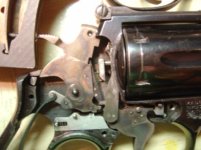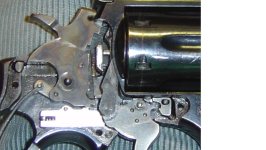Please do a search on S&W disassembly. It'll describe the proper method for taking your revolver apart.
That box that houses the spring is called the REBOUND SLIDE. It serves to return the trigger to its position of rest after the trigger is released. It also serves as an internal safety too. That's lump on the rebound slide that the "foot" of the hammer rests on is called the "shelf." The spring inside the rebound slide is the "rebound slide spring."
Here's how the safety works. If the gun is cocked and there is not pressure on the trigger (call it a malfunction), the rebound slide spring pushes the rebound slide forward, rebounding the trigger to its position of rest. The shelf of the slide intercepts the foot of the hammer, preventing it from going all the way forward. If the hammer cannot rotate all the way forward, the firing pin will not strike the primer. That's your internal safety. This feature was on the original Taurus revolvers but they deleted it (because they make a cheaper gun that looks to be the same as the S&W - and that's why I'll always buy S&W over Taurus - unless I get one cheap).
When you dry fire the gun without the sideplate in place, it'll tend to buckle the rebound slide up. That's natural. You'll have to use a finger to keep it from popping while you work the action.
Some more digression. The hammer has several parts. Ignoring the rivet that holds the firing pin, look further down and you'll see the spring loaded part. That's your Double Action Sear. When the trigger is pressed back, the "lip" as you call it rotates up and engages the bottom of the sear. This causes the hammer to cam back towards the cocked position. Further pressure on the trigger causes the hammer to rotate further to the rear such that the trigger disengages the sear. With no upward pressure against the sear, the hammer is pulled back to its position of rest by the leaf spring (via the stirrup) or to put it simply, pressure from the leaf spring forces the hammer forward. The hammer slams forward with the firing pin striking the primer. Boom.
When you release the trigger, the rebound slide spring pushes the rebound slide forward. This forces the trigger forward to its position of rest. As the rebound slide moves forward, the shelf engages the foot of the hammer and forces it slightly back and in so doing withdraws the firing pin from the firing pin hole. The hammer comes to rest atop the rebound slide shelf at about the same time the rebound slide comes to a stop.
Please bear this in mind when you reassemble your revolver. Since you have two and you've already done so, examine the 2nd one but don't play with it until you've reassembled your first one.


